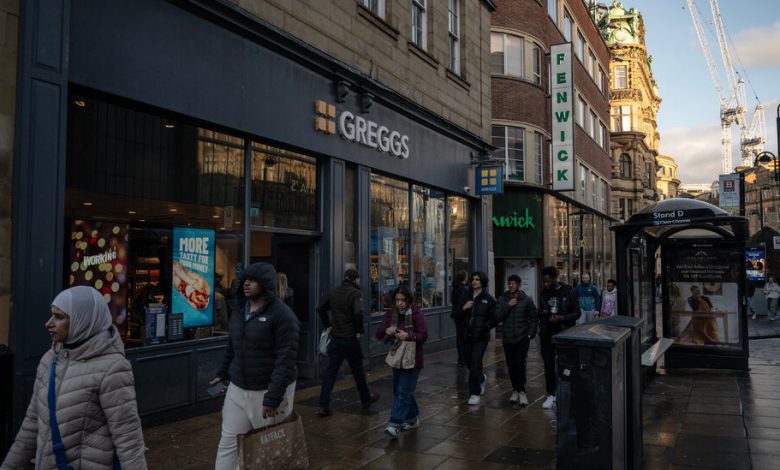How a Super Affordable Bakery Chain Became a British Culinary Icon

To most of this bakery’s millions of devotees, the idea that its “Steak Bake” could be “lifted” lies somewhere between folly and heresy. It brings diced beef, gravy and crisp puff pastry together in perfect harmony. It cannot be improved, or ameliorated, or heightened. It has already attained its highest form.
Its popularity attests to that. The bakery, Greggs, a family chain founded in 1939 to deliver door-to-door baked goods to mining communities around Newcastle, England, sells hundreds of thousands of them every week, mostly to customers who walk into one of their more than 2,300 branches around Britain and take them away in a paper bag, to be eaten hot, on the go.
Mark Reid and Kieran McBride, of the upscale Fenwick department store in Newcastle, decided this fall simply to play with it a little.
Mr. Reid, the store’s head chef, and Mr. McBride, its director, had about two months to take Greggs’s menu and turn it into a sophisticated bistro experience that would sit easily within Fenwick’s own, somewhat more refined environs.
Mr. Reid’s idea — pairing the Steak Bake with dauphinoise potatoes and a sheaf of fine green beans — was straightforward, Mr. McBride said. “I think most chefs would have done the same,” he said.
What mattered was the final flourish: sprinkling the whole thing with shaved truffle. “We wanted to lift it that one step further,” Mr. McBride said.
At first glance, Greggs Bistro, a monthlong pop-up restaurant located inside Fenwick’s flagship branch, seems an uneasy match. While both companies have their roots in Newcastle — Fenwick opened there in 1882 as a Mantle Maker and Furrier selling silks and furs, and now has nine stores around Britain — they occupy different ends of the market.
Greggs’s wares are designed to be eaten by the hungry in a hurry: The chain sells, for example, 130 million sausage rolls (priced at an affordable 1 pound and 20 pence each, about $1.50) every year.
Fenwick, meanwhile, sells brands including Ralph Lauren, Victoria Beckham and Eileen Fisher, and was for a long time home to a silver service French-inspired restaurant, complete with starched linen tablecloths, tie-clad waiting staff and fine china.
Both, though, saw a collaboration as a chance to blur the lines between what is perceived as high and low culture just a little, to “play with the form, infuse a little bit of irony,” as Mr. McBride put it.
The blend, it turns out, is a more natural fit than might be imagined. A Steak Bake, for example, works extremely well with shaved truffle. Another Greggs favorite, the seasonal “Festive Bake,” filled with chicken, stuffing, and cranberry sauce, is accompanied by duck-fat roast potatoes, smoked pancetta, chestnuts and sprouts, and served under silver cloches that are whisked away at the table. Gravy is drizzled on by impeccable waiting staff.
More complicated, for Mr. Reid, were the desserts. The “Yum Yum,” a twist of dough covered in sugar glaze that is a Greggs specialty, is served with caramel sauce and macadamia brittle, a magnitude of sugar that might, admittedly, set some people’s teeth on edge.
And the doughnut — well, the doughnut was an issue.
There is, Mr. Reid realized, no way to play with a doughnut’s innate structure. A doughnut, too, is a perfect whole. Instead, the chef tried to capture its essence. With the help of Mother Mercy, a local cocktail bar with a branch in Fenwick’s basement, he turned it into a drink: raspberry, apple and “doughnut flavor,” topped up with Prosecco. “It does really smell like a doughnut,” Mr. McBride said.
The results have been spectacular. Reservations at the bistro sold out, and there has been a steady stream of walk-ins. The “Pink Jammy Fizz” cocktail has been such a hit that Mr. McBride expects it to go on the menu in the basement bar once the bistro closes. “It will have to,” he said. “People will ask for it otherwise.”
That Greggs has moved so seamlessly, so successfully into its own tongue-in-cheek version of fine dining should not be a surprise. It has, after all, managed to conquer almost every other aspect of Britain’s culinary existence.
It now has more branches in Britain than any other fast-food outlet. In many small towns, particularly in the north of England and in Scotland, it is not unusual to see two Greggs within walking distance of each other.
As well as space, Greggs has come to dominate time. Roisin Currie, its chief executive, proudly claimed that this year it overtook McDonald’s to become “No. 1 for breakfast” in Britain. It has opened a number of branches with seating areas. “We are a food-to-go brand,” Ms. Currie said. “But sometimes, you want to sit down for a few minutes when you’re on the go.”
A growing number of outlets remain open in the evening, to catch consumers looking for a quick dinner. Greggs’s partnership with the delivery service Just Eat accounted for 5 percent of sales in 2022. The ambition, Ms. Currie said, is to meet customers “whenever, wherever, however.”
In her eyes, it is just the start. Greggs might dominate the high street, but there are other territories — airports, industrial and retail parks, hospitals — it feels it has barely permeated.
Her aim is to expand further, but she is conscious that comes with a risk. “We’re aware that there is a danger in seeming to be ubiquitous,” Ms. Currie said, “but we don’t think we’re there yet.”
Britain, as a whole, would appear to agree. Perhaps the most striking aspect of the country’s transformation into sovereign Greggs territory is the extent to which the conquest has been welcomed.
Most of the omnipresent chains that clutter Britain’s dwindling high streets are tolerated at best, or maligned at worst. Though Greggs has faced some criticism for its calorific products when more than half the British population is overweight or obese, it remains beloved.
Last year, Greggs launched several “drops” of branded clothing with the retail giant Primark, and they all sold out. At least two documentaries have been commissioned to discover the secrets of the Steak Bake. And during Britain’s first Covid lockdown, the company shared the recipe online so bereft customers could make their own.
It is seen as a “crutch, a prop-up, an umbrella on a rainy day,” the journalist and author Joel Golby wrote in The Guardian. “If you do not love Greggs, you do not love life.”
There are several available explanations. Ian White, Greggs’s brand director, traces it to nostalgia. “People have grown up with Greggs,” he said. “It reminds you of your childhood. You feel an ownership of it.”
Ms. Currie believes the “secret sauce” is Greggs’s staff — encouraged to build a bond with regular customers — and its prices. Greggs’s coffee, at roughly $2 a cup, is significantly cheaper than many rivals’. With average food prices up 27 percent in Britain since 2021, that affordability is key.
The final ingredient is a self-aware sense of humor that Britons love. There are, famously, precisely 96 layers of pastry in the company’s best-selling sausage roll — the 97th may well be irony.
As a brand, Greggs has an almost unifying quality. “Our customers cross all demographics,” Ms. Currie said. And because everyone goes to Greggs, expressing fealty is a way of coding a lack of pretension. The actor Jake Gyllenhaal, not exactly the target market for a Yum Yum, has previously admitted to indulging his Greggs habit on trips to London.
Rather than resist that frisson, the company has leaned into it. Mr. White described its approach as “not taking ourselves too seriously.” There is an awareness that Greggs is, to most, a bit of a “secret pleasure,” he said.
In 2019, professional culture warriors responded furiously to Greggs’s launch of a vegan sausage roll: the television host Piers Morgan spat one out on live TV and described the company as “PC-ravaged clowns” online. Unlike Mr. Morgan, Greggs did not bite. “Oh hello Piers, we’ve been expecting you,” it wrote on what was then Twitter. A month later, the chain attributed a 10 percent rise in sales to the vegan roll.
The clothing line, the decision to award the British rapper Stormzy with a “concierge card” and the silver service bistro all come with a similar wink and a nod. They are not taken as a sign that Greggs is getting above its station, but as proof that it is in on the joke.
“We know who we are,” Mr. White said. “We are part of the fabric of the country.”




